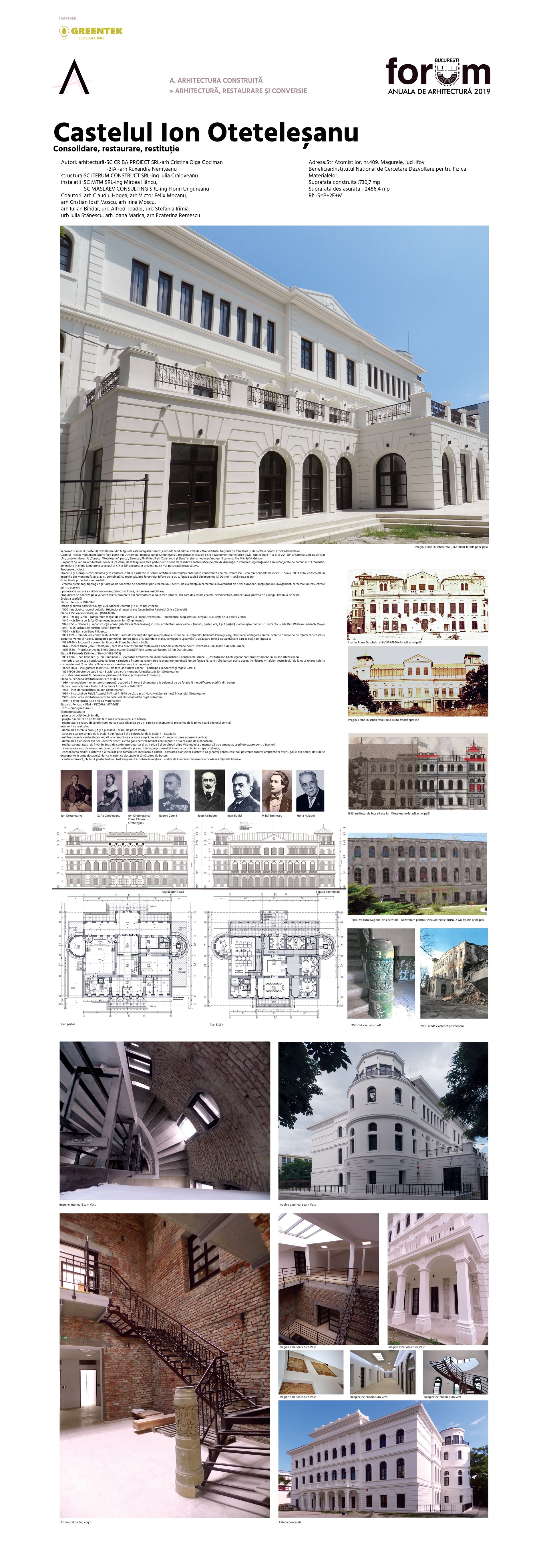
Ion Oteteleșanu-Consolidation, restauration,reabilitation

Authors’ Comment
At present Oteteleşanu Mansion in Măgurele is registered as “Corp M”, being managed by the National Research and Development Institute for Materials’ Physics. The Castle - a historic monument, is part of the “Oteteleşanu Mansion”, registered in the current Historical Monuments List (LMI), under the code IF-II-a-15 294. From the whole assemble there are classified in the LMI, the castle, called “Oteteleşanu Mansion”, the park, the Church “Holy Emperors Constantin and Elena” and the archaeological site together with the remains of the Grindu Monastery. From an architectural point of view, the mansion (castle) from Măgurele is part of a series of aristocratic endangered residences in Romania: noble residences surrounded by romantic-style parks, arranged in the first half of the 19th century. Of these, at present, only a few remain. The project aimed to consolidate and restore the existing building in the sense of restitution of the previous conformation considered the most valuable one from the Kalinderu - Slavici period 1893-1894, preserved in the images of Slavici's Monograph, combined with the reconstruction of the bifora windows from the second floor, the southern façade in the image of Dushek - the father (1863-1868). Space evolution Stage I. 1487-1840 period -the house and the court of the Cojeşti boyars Cula Stancăi Lady and Mihai Viteazul - 1800 - the nucleus of the manor house Hristodor and Iancu Vrana (similar to Ghica Caciulati Palace) Stage II. Oteteleşanu Period (1840-1888) - 1840 - 19 aug-5 new - the purchase of the estate by the minister Iancu Oteteleşanu - the president of the Magistrate of Bucharest from the boyars Vrana; - 1840 - marriage to Safta Cîmpineanu (sister of Ion Cîmpineanu); - 1841-1850 - restoration and reconstruction of the mansion (architect Xavier Villacrosse) in the style of neoclassical architecture - (basement, ground floor, 1st and 2nd floor) - park design in romantic style - assisted Karl Wilhelm Friedrich Mayer (1844 - 1845) by horticulturist F. Horner; - 1850 - marriage to Elena Filipescu; - 1863-1876 - Remodeling the manor house in the style of holiday chalets in the Italian-Austrian alpine area or the spa resorts of Karlovy Vary, Herculane, adding the great honor staircase on the facade N with two allegorical statues Venus and Apollo, adding the side towers on E and V, floor 2 extension and "glazing" configuration, adding the existing terrace to the park on the 1st floor on the facade S; - 1863-1868 - photographs of the mansion made by Franz Duschek - the father; - 1876 - Iancu (Ion) Oteteleşanu dies, leaving the will of the Romanian Academy for the founding of an Institute of Poor Girls; - 1876-1888 - Owner becomes Elena Oteteleşanu, born Filipescu, the heiress of Ion Oteteleşanu. Stage III. The Kalinderu-Slavici Period (1888-1908) - 1893-1894 - Ioan Kalinderu and Ion Cîmpineanu - testamentary executors, establishes the Institute for Poor Girls - “Ion Oteteleşanu Institute” according to the testament of Ion Oteteleşanu - remodeling under the leadership of Ioan Kalinderu meant the renunciation of the monumental staircase on the N facade, the construction of a balcony over access, the closure of the window glazing from the second floor, the union of the three bodies of the second floor on the North facade from access and the construction of the staircase in the West wing; - 18 Oct 1894 - inauguration of the Ion Oteteleşanu Institute of Girls - participates I.D. Sturdza and King Carol I; - 1894-1906 study director Ioan Slavici who writes the monograph of the Ion Oteteleşanu Institute; - permanent visitor M. Eminescu, friend with I. Slavici (Eminescu's kiosk). Stage IV. Period of the Institute of Girls 1908-1947 - 1930 - remodeling - abandoning the roof and covering in the terrace and renouncing the balcony on the North façade - modification of the “V” shaped staircase in concrete. Stage V. IFA Period - Institute of Atomic Physics - 1948-1977 - 1948 - closing the “Ion Oteteleşanu” Institute; - 1954 - The Institute of Atomic Physics set up in 1948 by Professor Horia Hulubei moves to Oteteleşanu Castle; - 1977 - evacuation of the Institute due to damage after the earthquake; - 1979 - becomes the Institute of Physics of Materials. Stage VI. IFTM Period - INCDFM (1977-2019) - 2011 - East tower crash. Interventions: - the demolition of the collapsed tower and the double floor over the building; - joining the large terrace from the first floor of the South facade and the balcony from the first floor - the North facade; - returning to the original centrality by giving up the wide wing of the West wing and rebuilding the central access; - demolition of the floorboards in the central lobby to create the central lighted zenithal through a succession of skylights; - creating educational and conference spaces on the ground floor and first floor in the East wing and office in the West wing; on the second floor and attic were arranged accommodation places for scholars; - arrangement of the existing basement as a museum of the castle and the proposed basement resulting from the consolidation with technical spaces; - the consolidation of the existing building was accomplished through the interior coating of the masonry, the preservation of the existing floors as a formwork for the new ones; keeping all old impressions, gaps in the walls of masonry discovered after the scraps as a witness, as cuttings in the concrete coating;Related projects:
2019
Built Architecture
Conversion and Restoration
Conversion and Restoration
- Restoration
- Zorileanu 18 - Residential building
- Deschis Gastrobar
- C_LAD
- Washington Villa
- Conservation and Enhancement of the Nicolae Minovici Museum in Bucharest and the Revitalisation of the Historical Enclosure
- Polonă Residence 24-26
- Time Tunnel
- Before & After, facade conversion
- The Painting Gallery of Căldărușani Monastery, Ilfov County
- Sanador Centre for Oncology
- Restoration, rehabilitation, refunctionalization for the C3 building in Museikon
- Ion Oteteleșanu-Consolidation, restauration,reabilitation
- Chamber of Fiscal Consultants Headquarters





